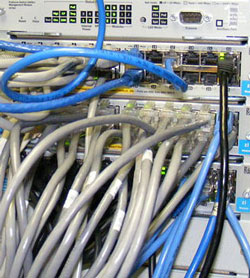By: John Shepler
A significant shift is occurring in the telecom industry as traditional circuit-switched networks are being replaced with packet-switched networks. This change brings with it the widespread availability of Ethernet connections, extending from individual locations to the internet. However, some organizations are hesitant to move on from their reliable T1 lines and SONET fiber optic services. This begs the questions: why should they consider transitioning, and to what?
 Are Ethernet Networks the Only Option?
Are Ethernet Networks the Only Option?
Ethernet is the foundation for most Local Area Networks (LANs), including wireless networks. While there are exceptions, like Fibre Channel used for connecting computers to Storage Area Networks (SANs), the majority of networking equipment and software is designed to support Ethernet.
What About T1, DS3, and SONET?
Long before packet-based communication, traditional telecom standards were established for combining telephone lines between phone company offices. These standards, using circuit switching instead of packet switching, operate by dividing a line into separate channels, each carrying a single phone conversation through a process known as Time Division Multiplexing (TDM).
Bridging the Gap Between TDM and Ethernet Networks
The technological differences between TDM and Ethernet or IP networks are evident. To address this, technology steps in to create a seamless experience for users. By combining the small telephone channels on a line, a larger bandwidth pipe can be established. Modules enable routers to connect to both external TDM lines and internal LANs. Although this method allows for modern computer communication, there are compelling reasons to move beyond this protocol conversion approach.
Comparing Ethernet Then and Now
The Ethernet protocol initially conceived in the 1970s differs greatly from its modern counterpart. The original Ethernet relied on a single-wire channel, leading to a “collision domain” where packets from all systems competed for access. This technology, known as “Carrier Sense Multiple Access with Collision Detection” (CSMA/CD), is a self-regulating system. In this system, each network connection must ensure a clear line before transmitting a packet and must be capable of recovery if a packet collision occurs.
While this system functions, it can become easily congested as devices are added and lines are interconnected with simple hubs. Communication is limited to half-duplex mode, allowing only one connection to transmit data at a time. Switched Ethernet, a significant advancement to this technology, remains in use today.
The Advantage of Switching
Unlike a shared line system, an Ethernet switch directs traffic from its source to its destination. With physically separate transmission and reception paths on different wire pairs, the network rate is doubled from half-duplex to full-duplex mode. Devices can both send and receive data concurrently, eliminating the collision domain. Each device has a dedicated network port, and the switch efficiently routes packets to their intended destinations.
Expanding Beyond the LAN
Connecting networks across different locations should ideally mirror connecting multiple smaller networks into a single LAN within a building. However, this hasn’t been the case because control over the network is relinquished when leaving a specific property. Connecting two business locations requires a connection across a neutral area using a common carrier. While this was initially the role of local phone companies, competition has opened this field to other providers.
Ethernet Expansion
Legacy switched-circuit telecom technologies have handled the transportation of voice, data, and video between locations for decades. Ethernet was initially restricted to LANs due to distance limitations for each network line. To overcome this limitation, Carrier Ethernet was introduced. This technology, retaining the core functionality of switched Ethernet, incorporates provisions for long-distance transmission, along with operation and maintenance features essential for carriers. Carrier Ethernet allows packets to be transmitted across cities and even globally.
Ethernet from End to End
Connecting an edge router to a familiar Ethernet connection (copper or fiber) at each business location is now feasible. The common carrier ensures the secure transfer of packets between locations, establishing a seamless Ethernet connection without the need for protocol conversions.
Benefits of Switched Ethernet Services
With switched Ethernet, it is possible to connect multiple locations and integrate their LANs into a larger network. Ethernet Line Service (E-Line) provides a one-to-one replacement for T1, DS3, and SONET OCx lines. Carrier Ethernet introduces additional options like Ethernet LAN Service (E-LAN), which creates a fully interconnected network requiring only an Ethernet connection at each location. Another option is Ethernet Tree Service (E-Tree), a one-to-many connection favored by content providers, where one location distributes traffic to numerous other locations.
The Cost-Effectiveness of Ethernet
Carrier Ethernet networks are designed for scalability and cost-efficiency compared to traditional telecom services. Obtaining Ethernet over Copper connections at 3 Mbps for the same cost as, or even less than, T1 lines at 1.5 Mbps is not uncommon. The cost difference becomes even more pronounced at higher speeds. The adaptability of this technology allows for easy and rapid service upgrades, often without requiring new equipment installation.
Considering Switched Ethernet
Switched Ethernet services offer the potential for enhanced services and increased bandwidth. Copper and fiber optic Carrier Ethernet services are currently widely available, making it a good time to explore the possibilities and discover the options.

